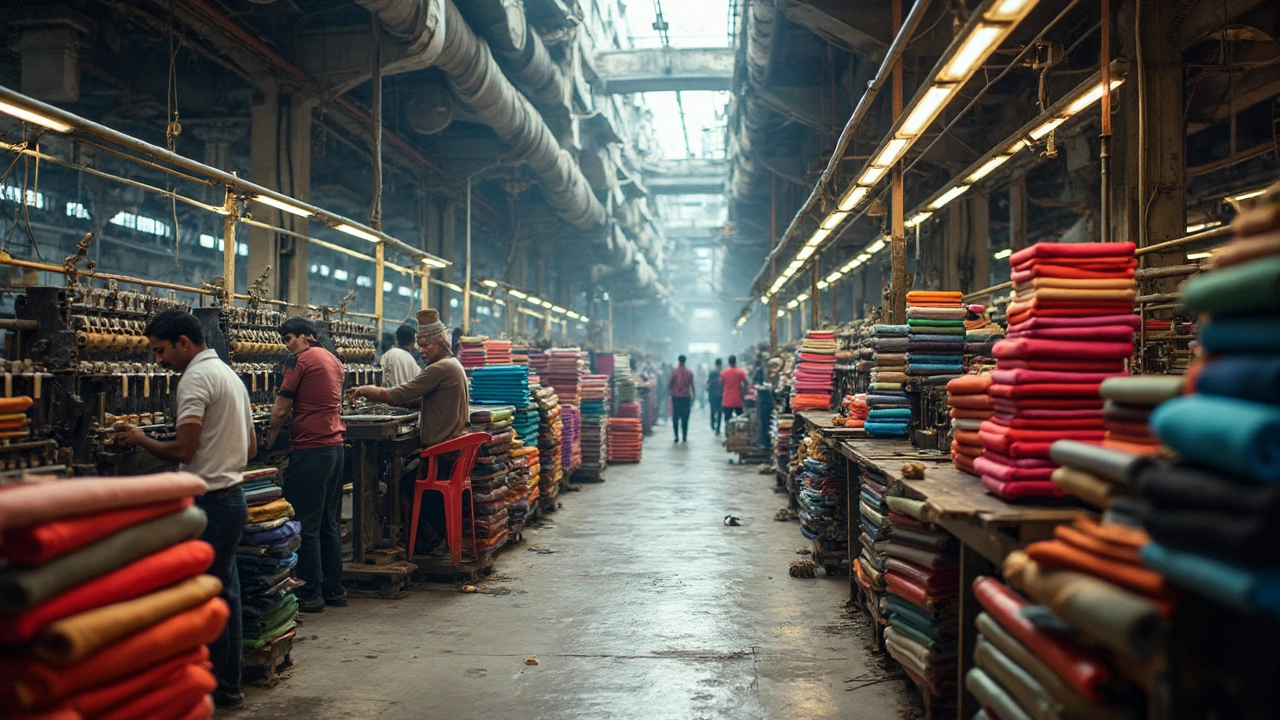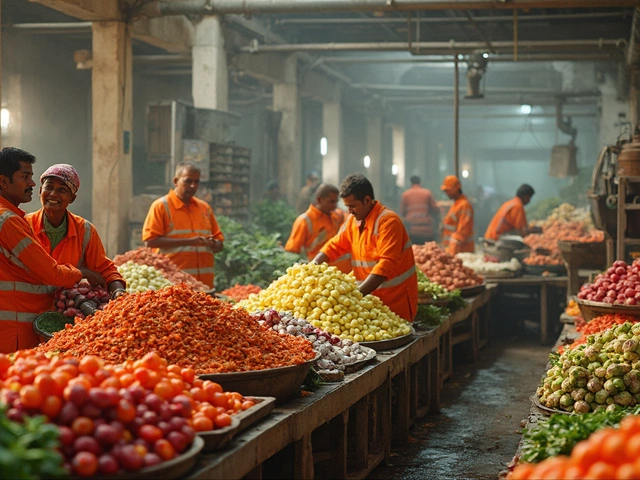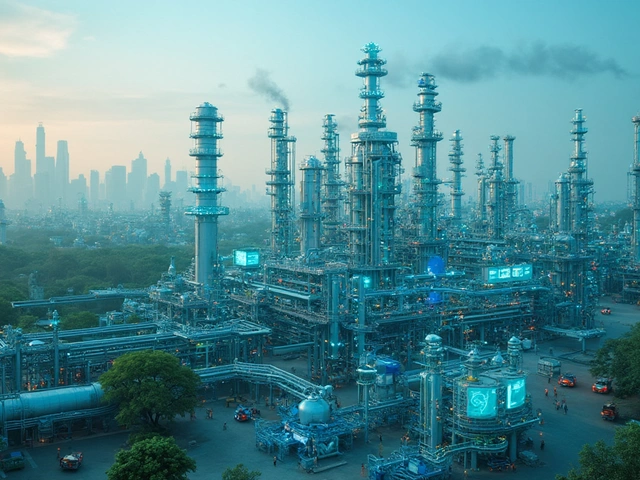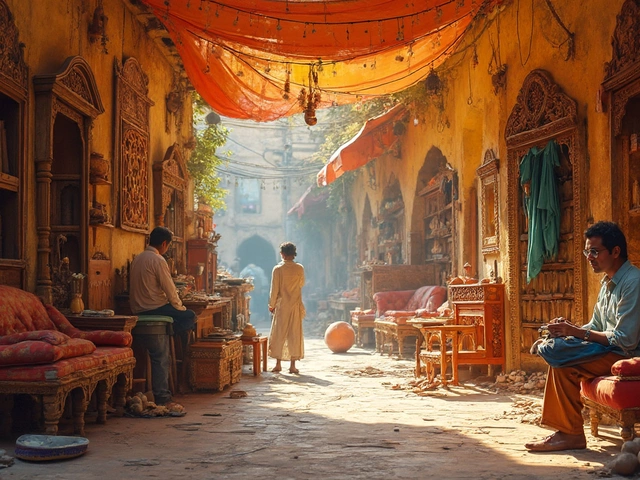The fight between Ahmedabad and Gandhinagar isn’t just about which city looks better on a postcard. If you’re interested in textile manufacturing, these two Gujarat neighbors might seem similar, but running a factory or setting up your business feels completely different in each.
Ahmedabad has been called the 'Manchester of India'—and not for nothing. This city has a textile industry history that goes back more than a century. You get old and new factories sitting side by side, tech parks popping up near legacy mills, and industry associations that can connect you with everybody from cotton suppliers to export agents.
But Gandhinagar is catching up. It’s got sleek roads, planned layouts, and a reputation for cleaner, less chaotic work spaces. The government rolls out incentives here—sometimes faster approvals, even extra infrastructure support for greenfield textile units. If you hate noise and crowds after work, Gandhinagar’s calm charms might win you over.
If you want to know where your textile venture will have lower costs, faster access to raw material, or a better shot at export deals, you’re in the right place. Comparing Ahmedabad and Gandhinagar isn’t a one-size-fits-all deal. One city might have cheaper labor; the other might win with government incentives or better logistics for dispatching products across India and abroad. So which city gets your business humming—and which one is just better for a textile manufacturer in 2025? Let’s get into the nitty-gritty and see where your reel spins faster.
- Ahmedabad’s Textile Legacy and Industry Ecosystem
- Gandhinagar’s Modern Touch and Up-and-Coming Scene
- Infrastructure, Connectivity, and Logistics
- Cost Factor: Land, Labor, and Utilities
- Government Support, Policies, and Red Tape
- Local Talent Pool and Business Ecosystem
Ahmedabad’s Textile Legacy and Industry Ecosystem
Ahmedabad barely needs an introduction when it comes to textiles. The city nicknamed the ‘Manchester of India’ kicked off its textile journey way back in 1861 with the very first cotton mill. Since then, Ahmedabad has grown into a full-blown hub for everything from spinning and weaving to printing and garments.
If you’re thinking about starting a textile factory here, you’re plugging into one of the most established networks in the country. Suppliers, chemical processors, machinery repair shops—everyone’s just a call away. Every major textile association, like the Ahmedabad Textile Mills Association (ATMA), is active here, regularly organizing industry meets.
A key reason manufacturers pick this city is because you’re not alone. In fact, over 120 active textile mills, a sea of small units, and leading names like Arvind Limited and Ashima Group make their base here. Here’s a quick look at the scale:
| Parameter | Value (2025) |
|---|---|
| Number of Textile Mills | 120+ |
| Direct Jobs in Textile Sector | ~200,000 |
| Annual Textile Output Value | ₹35,000 Crore |
| Key Exports | Cotton fabrics, garments, technical textiles |
Besides big numbers, it’s the culture of competition and innovation that helps. There are plenty of small-scale dyeing and printing units—handy if you want to experiment with fast runs or new products. You also get access to the textile research centers like ATIRA, which help local manufacturers step up their game with testing and R&D support.
The other major plus? The infrastructure’s already in place. While city traffic can get messy, railheads and warehouses are set up for bulk movement, and you’ll find easy connections to the nearby Mundra and Kandla ports for exports. If you’re focused on the Ahmedabad textile market, getting materials in and finished batches out is a well-oiled machine.
Want quick tips?
- Join local associations early—they often get advance updates on subsidies or raw material discounts.
- Tap into internships from Ahmedabad’s textile engineering colleges to find fresh, affordable talent.
- Explore local B2B marketplaces for spare part deals and machinery servicing.
Setting up in Ahmedabad might mean intense competition, but you also get a massive, ready-made ecosystem where almost every textile need is already covered.
Gandhinagar’s Modern Touch and Up-and-Coming Scene
Gandhinagar may not have the famous textile heritage like Ahmedabad, but it’s seriously upping its game for new-age textile manufacturers. The city, designed with wide roads and planned industrial zones, attracts companies who value order, plenty of space, and less pollution. In fact, Gandhinagar sits right next to the GIFT City financial hub, giving direct links to banks, export services, and global business consultants. That’s something old-school industrial zones in other cities can’t match.
One big perk here? The Gujarat government has rolled out textile policies aimed at giving special tax breaks, quick approvals, and help with setting up power and water lines. In 2023, the state started the “Textile Policy 2020-25” which makes starting and running a textile company a lot smoother, especially for medium-sized factories. From what many new entrepreneurs say, the paperwork is lighter, and officials are surprisingly responsive compared to city offices further south.
Check out this fresh data comparing Gandhinagar to surrounding cities on costs and facilities for textile set-ups:
| City | Average Industrial Land Price (per sq ft) | Typical Approval Time (days) | Power Reliability | Average Water Cost (Rs./kl) |
|---|---|---|---|---|
| Gandhinagar | ₹1,200 | 30 | Very High | ₹18 |
| Ahmedabad | ₹1,800 | 45 | High | ₹22 |
| Surat | ₹2,000 | 50 | Medium | ₹28 |
Gandhinagar also offers plug-and-play sheds in the Apparel & Garment Park, which means you can start operations without wasting time building from scratch. For anyone interested in green manufacturing, the city’s new Eco Industrial Parks boost your image and bring extra factory certifications.
What really sets Gandhinagar apart for textile businesses:
- Modern, well-planned industrial clusters—less chaos, less red tape
- Close ties to institutes like NIFT Gandhinagar (for skilled young designers)
- Fast-growing network of logistics players—so shipping your finished products is quicker
- Support from the state for everything from solar rooftop subsidies to worker training programs
If you’re looking for a spot where things just work, with a rising network of professionals and fewer old-school headaches, Gandhinagar’s up-and-coming textile scene offers a real chance for manufacturers ready to grow fast and steady.
Infrastructure, Connectivity, and Logistics
If you run or plan to launch a textile unit, you know how much daily operations depend on steady infrastructure, quick transport, and smooth logistics. Ahmedabad basically built its fame on these strengths. The city’s connected to every major metro by road, rail, and air—not to mention its close distance to Kandla and Mundra sea ports for exports. Moving goods in and out is rarely a headache here. For raw cotton or finished garments, Ahmedabad’s Sardar Vallabhbhai Patel International Airport helps with express imports or exports. Truckers love the city because of the efficient ring roads and expressways, while railway links like Ahmedabad Junction handle massive material flow every month.
But don’t count Gandhinagar out. It sits just 30 km away from Ahmedabad, using much of the same transport spine. The Gandhinagar-Ahmedabad Metro connects these two cities, slashing travel time for workers and business meetings. Gandhinagar is right on National Highway 8. The city is also benefiting from the new Delhi-Mumbai Industrial Corridor, making it more attractive for companies wanting modern logistics support.
Here’s a side-by-side look at the nuts and bolts—that textile manufacturers actually care about:
| Feature | Ahmedabad | Gandhinagar |
|---|---|---|
| Road Connectivity | Excellent – major highways, ring roads, city traffic manageable | Very Good – new roads, direct highways, easy truck access |
| Rail | Major junction, freight-friendly, direct network to metros | Connected via Kalol and nearby hubs, less traffic jams |
| Airport | International airport, cargo customs, 24/7 service | 30 km from Ahmedabad airport |
| Proximity to Ports | 110 km to Kandla, 400 km to Mundra port | 120 km to Kandla, 410 km to Mundra port |
| Electricity Supply | Reliable, stable; power cuts rare | Upgraded grid, good for new plants |
| Industrial Parks (Textile Focused) | Dholera SIR, GIDC estates, textile clusters close by | GIFT City, Apparel Park, new clusters on the rise |
For Ahmedabad, the sheer legacy and volume of established logistics service providers puts it ahead in handling large, daily textile shipments. You’ll find warehouses, cold storage, and express courier options close to factory zones. Gandhinagar’s edge is in fresh infrastructure—modern roads and less congestion, especially appealing if you’re setting up a tech-driven or export-focused textile plant.
If you want speed, cost-cutting, and connections to ports, Ahmedabad probably gives you a head-start. But for new-age manufacturing—think smart plants and digital logistics—Gandhinagar’s smoother streets and less crowded roads might mean fewer delays and less red tape down the line.

Cost Factor: Land, Labor, and Utilities
Looking at the costs to set up or run a textile unit, Ahmedabad and Gandhinagar go in different directions. Ahmedabad usually gets more attention for its affordable labor and ready-to-use industrial spaces, but Gandhinagar tries to make up the gap with government-backed incentives and hassle-free permits.
If you need land, Ahmedabad is more expensive. The city’s older industrial zones, like Narol or Vatva, can go from ₹20,000 to ₹35,000 per square yard depending on how close you are to main roads or current infrastructure. In Gandhinagar, the price for a piece of land in a developed sector or GIDC estate usually runs cheaper—more like ₹15,000 to ₹22,000 per square yard. And it’s easier to find larger, clear plots for greenfield projects in Gandhinagar.
| Factor | Ahmedabad | Gandhinagar |
|---|---|---|
| Industrial Land (₹/sq yd) | 20,000–35,000 | 15,000–22,000 |
| Average Skilled Labor Wage (₹/day) | 500–650 | 450–600 |
| Electricity (₹/kWh for industry) | 7.0–7.50 | 7.10–7.40 |
| Water Supply (₹/KL) | 20–25 | 16–22 |
Labor costs tell a similar story. People still flock to Ahmedabad for work, so skilled textile workers and machine operators are everywhere. Wages hover around ₹500–650 a day for skilled staff. In Gandhinagar, demand is lighter and it’s easier to find lower rates, especially for bigger projects that pull workers from villages nearby. Expect about ₹450–600 per day for skilled hands here—but be ready to spend a little extra on training or relocation if you need specialists.
Utilities look similar in both cities on paper. Industrial electricity rates are between ₹7 and ₹7.50 per unit in Ahmedabad, while Gandhinagar is a tad cheaper or the same. Water is slightly less expensive in Gandhinagar too, but only by a few rupees per thousand liters—not a game-changer unless you’re running a massive dyeing or processing outfit.
- If you’re eyeing land for expansion, Gandhinagar clearly wins for price and ease of getting approvals.
- Skilled labor is more “plug and play” in Ahmedabad, but cheaper in Gandhinagar if you invest in upskilling locals.
- Utilities are close enough, so the real cost saves are in land and, maybe, water.
Bottom line: If your margins depend on lower land and labor spend, Gandhinagar pulls ahead, especially for new, big units. If you value access to a workforce that already knows textile work inside and out, Ahmedabad costs more, but that extra spend can pay off in less downtime and training.
Government Support, Policies, and Red Tape
This is where things start to get real for anyone running or planning a textile business. Gujarat’s state government has a solid reputation for backing the textile industry, but there are some clear differences between what’s on offer in Ahmedabad versus Gandhinagar.
Gandhinagar is basically the capital, so it's literally where top state schemes and policy desks sit. Setting up here can sometimes mean getting government approvals, environmental clearances, and incentives sorted out faster. Textile units in Gandhinagar, especially those that qualify as new or “greenfield” projects, can grab subsidy packages, discounted energy, and even single-window clearances for most paperwork. The Textile Policy 2020-25 puts extra focus on value-added products, and the government has earmarked areas specifically for new industrial parks in Gandhinagar district—helping cut through a lot of red tape that slows business in older city centers.
Ahmedabad gets a slice of the same pie, but because it’s buzzing with older mills and fuller industrial zones, some policies are already baked in. If you own a legacy plant, you might have easier access to special modernization grants, or infrastructure upgrades under central government and state co-funded schemes. But on the flip side, expect more detailed inspections, legacy compliance checks, and slightly slower paperwork—just because you’re working in established industrial estates with their own rules and quirks.
For a straight-up view, here’s how typical government touchpoints stack up between the two cities:
| Support/Policy | Ahmedabad | Gandhinagar |
|---|---|---|
| Approval Speed (average) | 3-6 months | 2-4 months |
| Access to Land Subsidy | Within old zones only | Available for new parks/projects |
| Single Window Clearance | Selective (pilot estates) | Standard for new parks |
| Textile Policy Incentives 2020-25 | Focused more on modernization | Extra push for startups & greenfield units |
One solid tip: If you’re aiming for a brand new, export-focused setup, Gandhinagar ticks a lot of boxes for smoother permissions. But if you’re improving or expanding a traditional mill, Ahmedabad’s familiarity with the textile scene can work to your advantage, even if the process drags a little. Either way, connect with a local industry association—they’ll often speed up what the government paperwork tends to slow down.
Local Talent Pool and Business Ecosystem
Ahmedabad’s biggest edge comes from its strong base of skilled workers and a tight-knit network of experienced textile players. You’ve got generations of families who have worked in spinning, dyeing, garment stitching, and even design. Big names like Arvind and Ashima started here, and tons of locals have learned the ropes as part of these powerhouses. Training centers like ATIRA (Ahmedabad Textile Industry’s Research Association) keep churning out factory-ready workers, engineers, and managers who know the nitty-gritty of textile production.
Don't forget the education hubs—NIFT Gandhinagar is just next door, and its grads often prefer Ahmedabad to launch their careers because of the greater exposure and job opportunities. The city’s trade fairs and regular business meets are huge for networking. Want new suppliers or reliable logistics partners? You’ll get plenty of that just by having chai at the right canteen. As Sumit Shah, a well-known Ahmedabad-based textile exporter, says:
“In Ahmedabad, you don’t just find skilled people, you find people who’ve grown up around textiles. That experience makes all the difference.”
On the other hand, Gandhinagar is more a story of fresh beginnings. The city’s planned growth means you get new offices, modern tech parks, and clean infrastructure. While the talent pool is smaller, you’ll see a younger crowd eager to work, thanks to colleges and university branches around the city. The vibe is more corporate, with less of the family-run unit politics you sometimes face in Ahmedabad. There’s more demand for upskilling, and the state sometimes brings in short-term training just for new textile units.
- If you want industry veterans and suppliers at your doorstep, Ahmedabad is ahead.
- If you like calmer setups and want to shape a new working culture, Gandhinagar offers a blank slate.
- Ahmedabad wins for its cluster effect—suppliers, brokers, and logistics are just closer and more plugged in.
- Gandhinagar is drawing more talent from newer engineering and management colleges every year, but it’s still a work in progress.
Bottom line: For a textile manufacturer who relies on local networks and hiring experienced folks, Ahmedabad is a safer bet. If you’re building from scratch and want modern offices with fresh talent, Gandhinagar could surprise you—but patience is key while the ecosystem grows.






